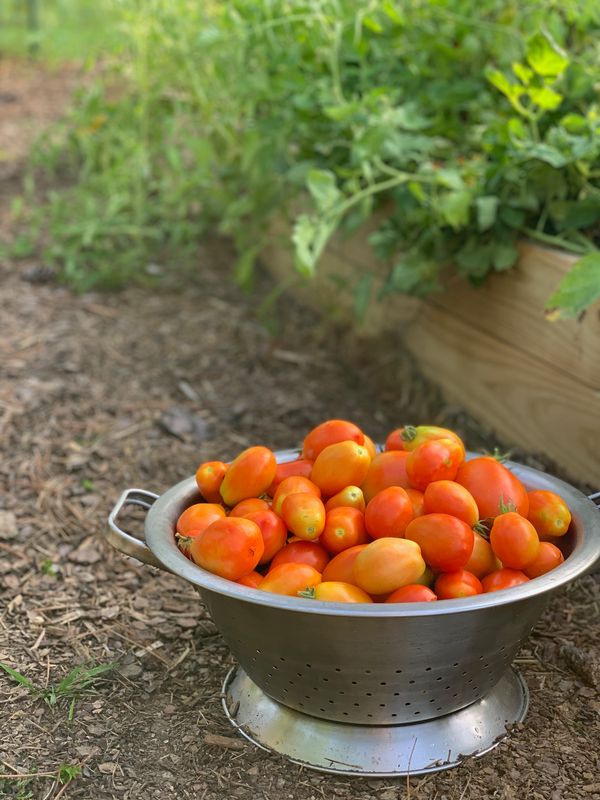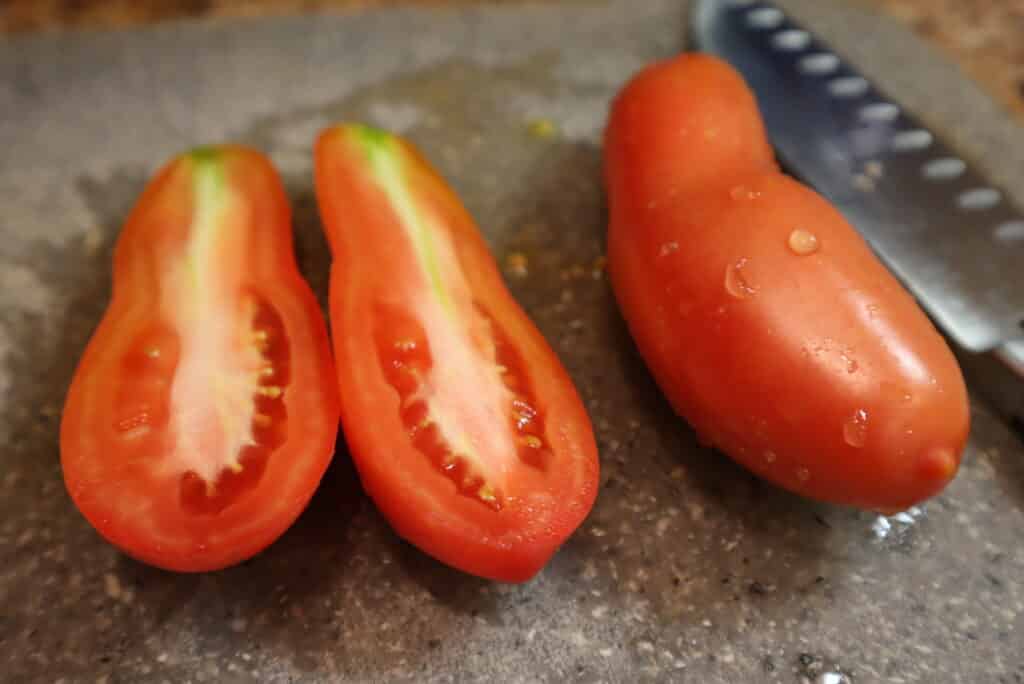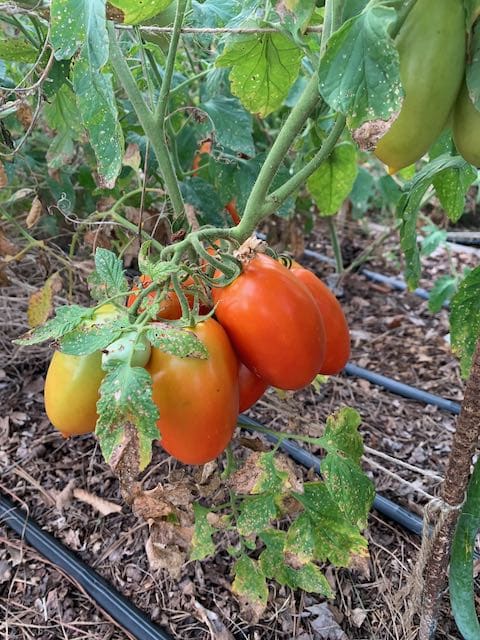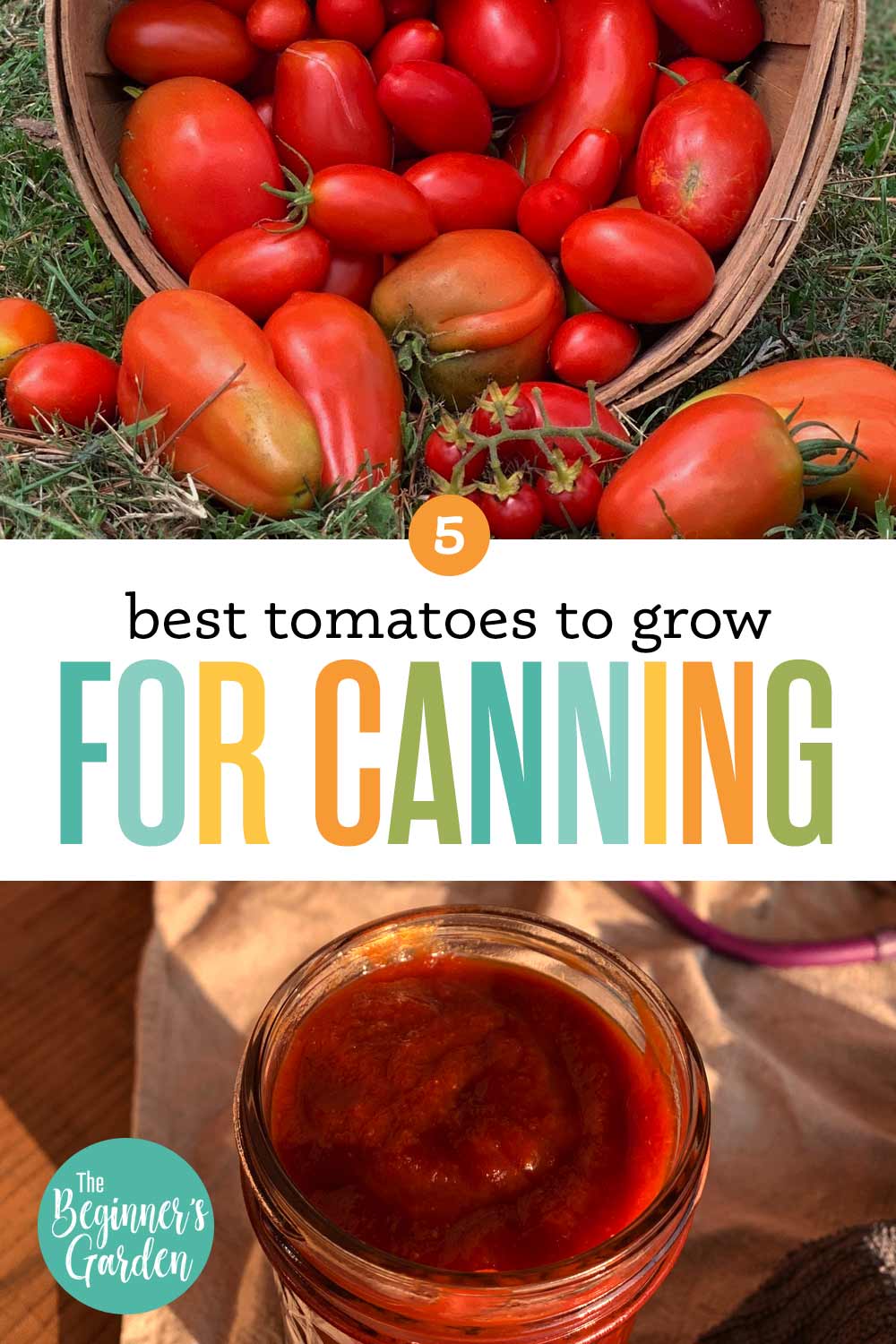Tomato Varieties Best For Canning
Are you looking to grow tomatoes so you can preserve them into home-canned products like tomato sauce, tomato paste, spaghetti sauce, salsa, and pizza sauce?
Most gardeners think just any tomato will work for canning. And technically, that’s true. BUT, to get more final product with less cooking time, some varieties are better suited for canning than others.
Here are some varieties to grow that work great for processing and canning.
*links below contain affiliate links which means if you click through and purchase, I will receive a small commission at no cost to you*
One of my goals in my garden each year is to can and preserve enough tomato products for my family for the entire year. From tomato sauce to pizza sauce, spaghetti sauce, diced tomatoes and more, I try to grow a year’s worth of it all.
In order to do that, I grow mostly paste tomatoes. Let’s talk about my favorite tomato varieties I grow to achieve that goal.

What is a Paste Tomato?
If you’re new to gardening, you may not know what a paste tomato is and why it matters.
Not all tomatoes are alike. You have options, such are cherry (small and round), grape (aka saladette, a little bigger and oblong), paste, and slicer (the big ones used for tomato sandwiches). While you can use any tomato to preserve with, paste tomatoes consist of more “meat” than juice and give you more bang for your buck so to speak. They have thick walls and more flesh in the center to be able to create a thicker tomato sauce.

While the options of paste tomatoes available to you are many (and thankfully, seed catalogs are starting to label them better to make it easier for you), below are the varieties I’ve grown in my garden and recommend for you to try.
San Marzano
San Marzano tomatoes are an indeterminate tomato that produce a heavy set of tomatoes early in the season. I love these tomatoes because when others shut down in the heat of the summer and quit producing, these don’t.
While the fruit they produce may not be quite as big if it’s very hot, they can still keep up. I love their thick walls that fit well into my fruit and vegetable strainer attachment on my KitchenAid Mixer.
Another great thing about them is that they detach from the stem easily so I don’t have to spend time in the kitchen removing stems. It may seem like a small thing but when you have 100 tomatoes to process, that time can add up.

The only drawback I’ve found to San Marzano tomatoes is that they are the first to develop blossom-end rot. Paste tomatoes in general are more susceptible to this physiological disorder, but San Marzano present with the problem more than the others.
Pink Fang
Pink fang tomatoes were new to me last year and they impressed me right out of the gate! This is another indeterminate heirloom variety that will set fruit all season long. These tomatoes are more long and skinny so they fit through my vegetable strainer very easily. This variety has very little juice and tons of flesh making it the perfect option for sauces.

In my experience in 2022 with extreme heat (around 100F) that went on for weeks, the pink fang tomato didn’t deal with blossom end rot like my other varieties did. It was a heavy producer all season long as well and didn’t seem phased by the high temps.
The primary drawback to the Pink Fang tomato would apply to you if you like to save seeds from open-pollinated fruit. Each tomato doesn’t produce many seeds, so you would have to save seed from several fruit in order to get enough to use next year. But, if you don’t care to seed save, having fewer seeds may be a benefit.
Pink fang tomatoes also did not take off as fast for me in the early spring. They seem to prefer the hotter temperatures and will instead sulk and grow slowly in cool weather. For that reason, if you live in a climate with cooler summers, this may not be the best option for you. If you do choose to grow pink fang, make sure to wait and plant it after your average last frost date has passed and maybe even a little longer.
Amish Paste
The Amish Paste tomato is an indeterminate tomato that is larger in size than the other two. While this one won’t fit through my strainer attachment well (it can be as large as a baseball), I like to use it for recipes that call for blanching and peeling tomatoes, such as diced canned tomatoes. I also love to use it on the grill to create salsa for a nice roasted tomato flavor.

These plants can produce tons of tomatoes each year, but they don’t love hot temperatures. If you live in a hot climate or have a really hot summer, you won’t get the fruit set that you would if you lived somewhere that stayed more mild in the summer.
One way I have found to get around that is to plant black eyed peas up a trellis near the tomato plant to help shade the plant from hot afternoon sun. This will cool the tomato plant just slightly so it can produce once the heat has ended and black eyed peas love the heat of the summer.
Amish Paste tomatoes, in my experience, also are more susceptible to fungal diseases that thrive in rainy weather. If your climate veers toward the wet, this may exacerbate the fungal disease.
Roma
This determinate tomato is one that I rely heavily on for my canning and preserving each year. Roma is a variety I have grown from my very first garden, over 10 years ago. With this being a determinate variety, it will stay on the shorter side (3-4 feet tall) and bear all it’s fruit over a 3-4 week timespan.
This makes it ideal for canning large batches of tomato products at one time. Because of its shorter fruiting window, it will fruit earlier in the season than some other indeterminate varieties. This works well for my hot climate since tomatoes usually drop their blossoms in the heat of the summer.

Good news with Romas is they don’t require pruning. In fact, pruning them would cut off some of their fruit set because they are bred to bear a determined amount of fruit.
Romas are a pretty low maintenance type of tomato overall and are great for beginners to start with. As long as you do a good job staking them up (I use the Florida weave), they will grow without much other care.
Paisano
The Paisano tomato is quickly became a favorite canning tomato in my garden. Like Roma, it is also a determinate variety that grows on the smaller side; it tops out at around 2-3 feet tall.
Paisano, in my first year in growing it, started fruiting before any of the rest of my tomato plants did. Because of that, it was able to provide a good harvest before the heat set in. The fruit are also larger than the Roma tomatoes are. It makes it another great candidate for salsa or diced tomatoes because you get more large fruit to work with.

Each year, I’m trying new paste tomato varieties to compare. This year, I’m trying Hungarian Heart, Opalka, and Pomodoro. What about you? Do you have a favorite paste tomato variety I haven’t listed here? Comment below!
What if you already have tomatoes growing and you’re ready to can? If you need to know just how many tomatoes you would need to create your own canned tomato products, click here to download my free Harvest to Jar Estimator.

